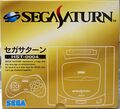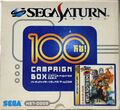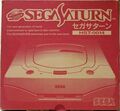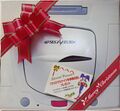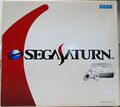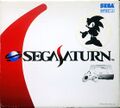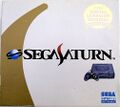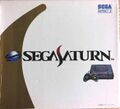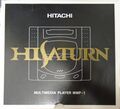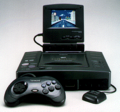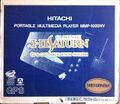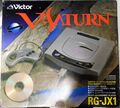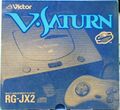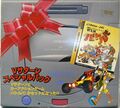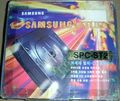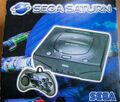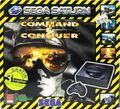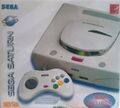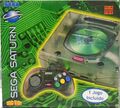Difference between revisions of "Sega Saturn consoles"
From Sega Retro
m (spelling/grammar/fixes) |
|||
| Line 1: | Line 1: | ||
There exist various [[Sega Saturn]] models, which differ from each other to varying degrees. Perhaps the most publicised difference is that between “Model 1” and “Model 2” Saturns, which differ in the design of their Power and Reset buttons—oval in the former, round in the latter—as well as internally (chiefly by different types of CD cable, which can hinder efforts to install a modchip). | There exist various [[Sega Saturn]] models, which differ from each other to varying degrees. Perhaps the most publicised difference is that between “Model 1” and “Model 2” Saturns, which differ in the design of their Power and Reset buttons—oval in the former, round in the latter—as well as internally (chiefly by different types of CD cable, which can hinder efforts to install a modchip). | ||
| − | All [[Sega Saturn | + | All [[Sega Saturn]]s are either [[NTSC]] or [[PAL]]. US and Canadian (NTSC) Saturns are identical, as are European and Australian (PAL) models. There was no [[SECAM]] Saturn; the "SECAM" models released in France were PAL models with a converter. |
The model number is printed on the information label on the rear of the console. | The model number is printed on the information label on the rear of the console. | ||
| Line 66: | Line 66: | ||
|- | |- | ||
|HST-0017 | |HST-0017 | ||
| − | |[[ | + | |[[Christmas NiGHTS into Dreams|Christmas Nights]] Campaign Box - HST-3220 |
|1.01 | |1.01 | ||
|22-11-96 | |22-11-96 | ||
| Line 258: | Line 258: | ||
|- | |- | ||
|RG-JX2-C | |RG-JX2-C | ||
| − | |V-Saturn RG-JX2 [[ | + | |V-Saturn RG-JX2 [[Christmas NiGHTS into Dreams|Christmas Nights]] Campaign |
|1.01 | |1.01 | ||
|11-1996 | |11-1996 | ||
| Line 284: | Line 284: | ||
Some more interesting notes about this system: | Some more interesting notes about this system: | ||
| − | *The reset switch is very short, and intended for use with a small sub-PCB immediately underneath mounted to the top of the shell. There is only 1 of 2 mounting holes for this PCB to attach to, however, and there's no evidence the single mount was ever used. There's also no sign of an extension rod which could reach the actual reset switch on the mainboard, some 5cm away. This system has no reset button! | + | *The reset switch is very short, and intended for use with a small sub-PCB immediately underneath mounted to the top of the shell. There is only 1 of 2 mounting holes for this PCB to attach to, however, and there's no evidence the single mount was ever used. There's also no sign of an extension rod which could reach the actual reset switch on the mainboard, some 5cm away. This system has no reset button! |
| − | *The power switch is mounted on two tall plastic legs on the bottom of the shell. All other oval button models have the power switch mounted directly underneath the button on the top of the shell, and round-button models have a power switch attached to a metal riser platform, not plastic legs. | + | *The power switch is mounted on two tall plastic legs on the bottom of the shell. All other oval button models have the power switch mounted directly underneath the button on the top of the shell, and round-button models have a power switch attached to a metal riser platform, not plastic legs. |
| − | *The CD mechanism has two small bundles of wires in addition to the data ribbon, which is unusual: all the newer mainboards had only one bundle, so again there's a weird combination here. | + | *The CD mechanism has two small bundles of wires in addition to the data ribbon, which is unusual: all the newer mainboards had only one bundle, so again there's a weird combination here. |
| − | *The oval button system has always had two LED indicators on the top of the shell: One for power, one for drive-activity. This unit is no different, except it is! The top of the shell has a rectangular indentation for the LED to be inserted (Again on a small sub-PCB that isn't present in this model) and no acrylic riser to focus the mainboard-mounted LED through the panel hole, some 5cm away. This system has no power light! | + | *The oval button system has always had two LED indicators on the top of the shell: One for power, one for drive-activity. This unit is no different, except it is! The top of the shell has a rectangular indentation for the LED to be inserted (Again on a small sub-PCB that isn't present in this model) and no acrylic riser to focus the mainboard-mounted LED through the panel hole, some 5cm away. This system has no power light! |
*Even though there's a hole for the activity light, there is no activity LED on either a sub-PCB or on the mainboard. There's an Activity label in both English + Korean but there's no Drive Access LED. | *Even though there's a hole for the activity light, there is no activity LED on either a sub-PCB or on the mainboard. There's an Activity label in both English + Korean but there's no Drive Access LED. | ||
Revision as of 02:27, 11 January 2012
There exist various Sega Saturn models, which differ from each other to varying degrees. Perhaps the most publicised difference is that between “Model 1” and “Model 2” Saturns, which differ in the design of their Power and Reset buttons—oval in the former, round in the latter—as well as internally (chiefly by different types of CD cable, which can hinder efforts to install a modchip).
All Sega Saturns are either NTSC or PAL. US and Canadian (NTSC) Saturns are identical, as are European and Australian (PAL) models. There was no SECAM Saturn; the "SECAM" models released in France were PAL models with a converter.
The model number is printed on the information label on the rear of the console.
Contents
Japanese Models
Grey Japanese Saturn
The original Japanese Saturn model is grey in color—except the cartridge slot flap and the front, which are black—and came in a box labeled HST-0001. It has three blue buttons (Power, Open and Reset), a drive Access LED and a non-notched power cord. All models sport the oval buttons characteristic of older “Model 1” Saturns. Production was later ended in favor of the white Saturn.
White Japanese Saturn
‘White’ Saturns are no more white in reality than Dreamcasts are; both are very light gray. There are two models of white Saturn. The first is based off the first generation Saturn with purple oval buttons, and the second is the traditional second generation model with round grey Power and Reset buttons, a pink Open button, and no drive Access LED. The systems came packed with a matching white controller with multi-colored buttons, similar to a Super Famicom controller except only the bottom row buttons are colored: green, yellow, and blue respectively; the upper buttons are grey, as is the cartridge slot flap. It is also rumored(?) that the White Saturn may have a slightly faster CD access time.
| Reference | Designation | Bios | Date | Price | Notes |
|---|---|---|---|---|---|
| HST-0001 | Saturn console gray HST-3200 / HST-3210 | 1.00/1.01 | 22-11-1994 | 44,800¥ | |
| HST-0004 | Saturn console gray HST-3210 | 1.01 | 16-06-1995(?) | 44,800¥ | |
| HST-0005 | Saturn HST-3210 | 1.01 | 16-06-1995 | 34,800¥ | 1,000,000th Campaign Box + Virtua Fighter Remix. |
| Reference | Designation | Bios | Date | Price | Notes |
|---|---|---|---|---|---|
| HST-0014 | Saturn console white - HST-3220 | 1.01 | 22-03-96 | 20,000¥ | Some were bundled with Virtua Fighter 2. |
| HST-0017 | Christmas Nights Campaign Box - HST-3220 | 1.01 | 22-11-96 | 20,000¥ | Same console as HST-0004 (accessories: HSS-0119 and HSS-0102. |
| HST-0019 | Saturn console white - HST-3220 | 1.01 | 10-07-97 | 20,000¥ | In March, some were bundled as a Toys 'R' Us edition with a Sonic stencil |
- Sega saturn white 1.jpg
Model 1
Skeleton Saturn
The two ‘Skeleton Saturns’ were the final models to be produced in Japan (and hence the world), and they were the only non-standard models brought to other regions(?). They are a valuable collectors item, being quite rare. The unique feature that provides their name are their see-through body and matching controllers. Other then that, they're basically identical to the second version of the white Saturn, although both have compatibility problems with Space Harrier and Metal Slug.
Models:
- HST-0020/HST-0021: These two models were both translucent smoky grey, with "This is Cool" printed on the CD drive lid and the controllers. The second model, HST-021, was the only one released outside of Japan. Approximately 30,000 units for Japan and 50,000 for the US were produced. HST-0021 was released in Japan on 4 April 1998 retailing at ¥20,000.
- HST-0022: This model was a promotional tie-in with ASCII's popular horse racing simulation game Derby Stallion; it came with stickers for the game and says something about the game on the box. There is no "This is Cool" printed anywhere on the system. Approximately 20,000 were produced for Japan and mass exported to the other regions. After limited supplies of the Skeleton Saturn, this was quickly bought in bulk by exporters and for a time was easier to find outside Japan than inside. This model was released in Japan on 25 March 1999 retailing at ¥20,000.
| Reference | Designation | Bios | Date | Price |
|---|---|---|---|---|
| HST-0020 | Skeleton Campaign Console | 1.01 | 1998 | Free? |
| HST-0021 | Skeleton console - HST-3220 | 1.01 | 04-04-1998 | 20,000¥ / $200 (USA) |
| HST-0022 | Skeleton / derby stallion - HST-3220 | 1.01 | 25-03-1999 | 20,000¥ |
SunSeibu SGX
The SunSeibu SGX is a modified Saturn in a steel enclosure hooked up to a coin operated mechanism and a 7 disc CD-ROM changer. It was manufactured primarily for use in Japanese hotels although a few entrepreneurial types installed them in arcades.
Additional info can be found [here http://nfggames.com/games/sgx/].
Asian Models
Hi-Saturn
Sega licensed the rights to produce Saturns to some of their hardware partners. One was Hitachi, who provided the CPUs and several other chips. The Hi-Saturn is yet another early style Saturn but with the MPEG decompression hardware built in, and Hi-Saturn printed on the CD drive lid. It's manufactured by Hitachi, and was supposed to cost less then a White Saturn with an optional MPEG card added in.
The unit is a dark charcoal color. It's not as black in color as the US Saturn but pretty close. Also, the buttons on it are circular, not oval, like subsequent Saturn units. The buttons are a khaki looking color. The machine has a very drab feel to it. The box it comes in is very plain looking almost all black with a light gray/white border and golden letters.
The start up screen is different as well. Instead of a bunch of pieces forming together, the word Hi-Saturn shoots out from the middle of the screen and then flips around 'till it's readable and then it flashes on screen like other Saturns do.
Controllers have the same color layout as the unit. The buttons are khaki and a gloomy looking blueish/gray. The controllers say Hitachi on them.
Models:
- MMP-1 / MMP-1C: These models are based of the first major Saturn model, with oval buttons and Drive Access LED.
- MMP-11: This model is based of the second major Saturn model, with round buttons instead.
- MMP-1000NV: Known as the Hi-Saturn Navi, this model is much different from all other Saturn models, both in design and funcionality. It has a lower, more square profile, and an add-on LCD monitor for playing games on. The system is completely flat on top and lacks the bulge of the CD drive. The system also had a GPS receiver sold seperately (with only Japanese regional software being available). 2000 units were produced by Hitachi each month, while the LCD screens had a run of 1000 per month.
| Reference | Designation | Bios | Date | Price | Notes |
|---|---|---|---|---|---|
| MMP-1 | Hi-Saturn model 1 | 1.01 | 01-04-1995 | 64,800¥ | |
| MMP-1-C | Hi-Saturn MMP-1 1,000,000th Campaign Box + Virtua Fighter Remix | 1.01 | 16-06-1995 | 54,800¥ | |
| MMP-11 | Hi-Saturn model 2 | 1.02 | 1996 | ||
| MMP-1000NV | Hi-Saturn Navi | 1.01 | 06-12-95 | 150,000¥ | Flier (cover, inlay) |
JVC/Victor V-Saturn
As said before, Sega licensed the rights to produce Saturns to some of their hardware partners. Besides Hitachi, the other one was JVC-Voctpr, who produced the CD drives for most models, although functionally identical Sanyo drives were sometimes used. There are two versions of this system. The casing is similar to that of any standard Saturn. The colors are different, as is the machine's circuitry, and "V-Saturn" is printed on top of the machine. The boot-up sequence on a V-Saturn has the polygons form a V-Saturn logo instead of the SegaSaturn logo, of course. The boot-up screen on the second one shows "Ver. 1.01" just as it does on white Saturns have been seen to do.
Models:
- RG-JX1: This model is based on the first major Saturn model, with Drive Access LED and oval buttons (one blue, the other grey to match the Access button) and is two toned gray with black as bottom second tone.
- RG-JX2: This model is based on the second major Saturn model, with blue round buttons, a red Access button and is two toned gray with darker gray as bottom color. From inspecting the later version, it is identical in every way to the Sega machine aside from color and markings, to the point one can suspect both are made by the same people, or at minimum are made out of exactly the same parts (all the plastic moldings are identical etc.).
| Reference | Designation | Bios | Date | Price | Notes |
|---|---|---|---|---|---|
| RG-JX1-L | V-Saturn RG-JX1 | 1.00/1.01 | 22-11-1994 | 44,800¥ | Equivalent to HST-0001 |
| RG-JX1-S | V-Saturn RG-JX1 | 1.00/1.01 | 16-06-1995 | 34,800¥ | Equivalent to HST-0004 |
| RG-JX1-LC | V-Saturn RG-JX1 1,000,000th Campaign Box + Virtua Fighter Remix | 1.01 | 16-06-1995 | Equivalent to HST-0005 | |
| RG-JX2 | V-Saturn RG-JX2 | 1.01 | 07-06-1996 | Equivalent to HST-0014 | |
| RG-JX2-B | V-Saturn RG-JX2 BattleBa Campaign Console | 1.01 | 06-12-1996 | ||
| RG-JX2-C | V-Saturn RG-JX2 Christmas Nights Campaign | 1.01 | 11-1996 | Equivalent to HST-0017 |
Samsung Model
It seems that in 1996, while LG was distributing the 3DO in Korea and Nintendo was distributed by Hyundai, Samsung had no competing game product of their own. While Samsung had previously sold a bootleg Master System (And a Mega Drive, although it is not known if this was an official or bootleg product) the Saturn was apparently licensed from Sega. It was made only for South Korea. The Japanese language option was removed from the setup screen on some models, though there wasn't a Korean option added in compensation, and there aren't any apparent changes to the bootup menus either. They also use the North American region code. Samsung later released a conversion kit for Japanese games.
The hardware seems to be an interesting mix of both new and old model Saturn systems from Sega and licenses JVC + Hitachi. Shares its outer design with the first major Saturn model (oval-buttons and shell), combined with the smaller and newer mainboard which normally comes with a round-buttoned shell.
Some more interesting notes about this system:
- The reset switch is very short, and intended for use with a small sub-PCB immediately underneath mounted to the top of the shell. There is only 1 of 2 mounting holes for this PCB to attach to, however, and there's no evidence the single mount was ever used. There's also no sign of an extension rod which could reach the actual reset switch on the mainboard, some 5cm away. This system has no reset button!
- The power switch is mounted on two tall plastic legs on the bottom of the shell. All other oval button models have the power switch mounted directly underneath the button on the top of the shell, and round-button models have a power switch attached to a metal riser platform, not plastic legs.
- The CD mechanism has two small bundles of wires in addition to the data ribbon, which is unusual: all the newer mainboards had only one bundle, so again there's a weird combination here.
- The oval button system has always had two LED indicators on the top of the shell: One for power, one for drive-activity. This unit is no different, except it is! The top of the shell has a rectangular indentation for the LED to be inserted (Again on a small sub-PCB that isn't present in this model) and no acrylic riser to focus the mainboard-mounted LED through the panel hole, some 5cm away. This system has no power light!
- Even though there's a hole for the activity light, there is no activity LED on either a sub-PCB or on the mainboard. There's an Activity label in both English + Korean but there's no Drive Access LED.
Additional info can be found here.
- Sega Saturn Samsung-2.jpg
Samsung model top view
- Sega Saturn Samsung controller.jpg
Samsung model controller
U.S./Canadian Models
All Sega Saturn models are black in color. There were at least three different subversions released, and the differences varied, but were generally minor except cosmetic and jumper locations.
Models:
- MK-80000: Manufactured from approximately April 1995 to March 1996 and it's identical to the Japanese grey model except in color.
- MK-80000A: Manufactured from March 1996 to July 1996. It featured a notched power cord, no drive access light, round power and reset buttons, and a 1.00a BIOS. Jumper locations are once again different.
- MK-80001: Manufactured starting July 1996. It's similar in appearance to the MK-8000A model, with difference being some of the jumper locations.
- Saturn1 US Box Back.jpg
European/Australian Models
These models are all black and externally quite similar to the NA models except they naturally run at a 50Hz PAL frequency. Production run model numbers are very similar except they have a 2 in place of the third digit. A US MK-8000A would be an MK-80200A in Europe. The odd exception is the MK-80200-50, which has no US equivalent. Also, EU/AUS machines will have "PAL" next to the BIOS revision number on the system settings screen instead of "NTSC", unless the system has been modified. There is no SECAM Saturn. The French used the same PAL Saturn as the rest of Europe but with a different RF/SCART adapter.
Models:
- MK-80200 / MK-80200-50 (PAL model 2): The first is unconfirmed, though it's safe to assume if it exists it's based on the first major Saturn design. The second is based on the first major Saturn design, is jet black with oval buttons and has a Drive Access LED. One green power light next to the power switch, One orange Drive Access LED next to the Reset button, large trapezoid like eject button, usual Saturn styling, air holes in the side casing unlike some later models. Version 1.01a BIOS.
- MK-80200A-50 / MK-80201 (PAL model 2): The first is based on the first major Saturn design, is jet black with grey round buttons and lacks a Drive Access LED. There were at least four different motherboard revisions used in these models. Something of interest is that some early examples have 'Model 1' revision motherboards. The second is unconfirmed, though it's safe to assume if it exists it's based on the second major Saturn design.
- Sega Saturn PAL model 1.jpg
Sega Saturn PAL model 1
- Saturn1 EU Box Front VirtuaFighterClockworkKnight.jpg
- Saturn2 EU Box Front SegaRally.jpg
Brazillian Models
Like the Sega Master System and Sega Mega Drive before it, the Sega Saturn was distributed by Tectoy in Brazil. Like the European models they run at 50Hz PAL frequency (PAL-M, to be exact) but surprisingly, a couple of the Japanese color schemes made it to this region.
Models:
- "White": The order of Saturn releases in Brazil is currently unknown, but this white version, similar to the Japanese's HST-0014 model, seems to be the most common. It was bundled with one free game.
- "Black": This black version similar to the Model 1 North American/European/Australian versions was also released, bundled with Virtua Fighter.
- "Skeleton": A set of skeleton Saturns were also produced for Brazil, assumedly a bit later than the other two.
- TecToySaturnTransparent BR Box Side 1.jpg
Skeleton model box (side)
- TecToySaturnTransparent BR Box Side 2.jpg
Skeleton model box (other side)


